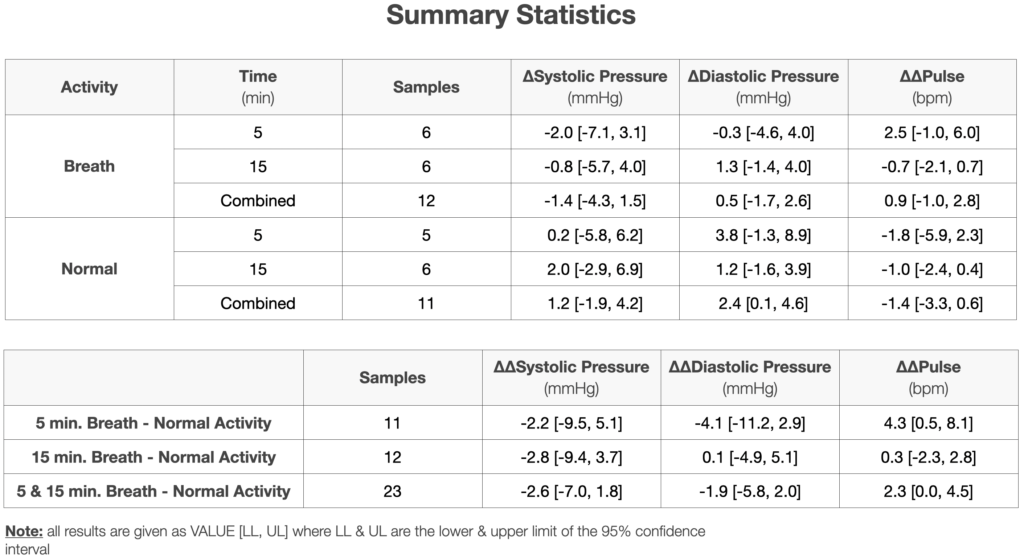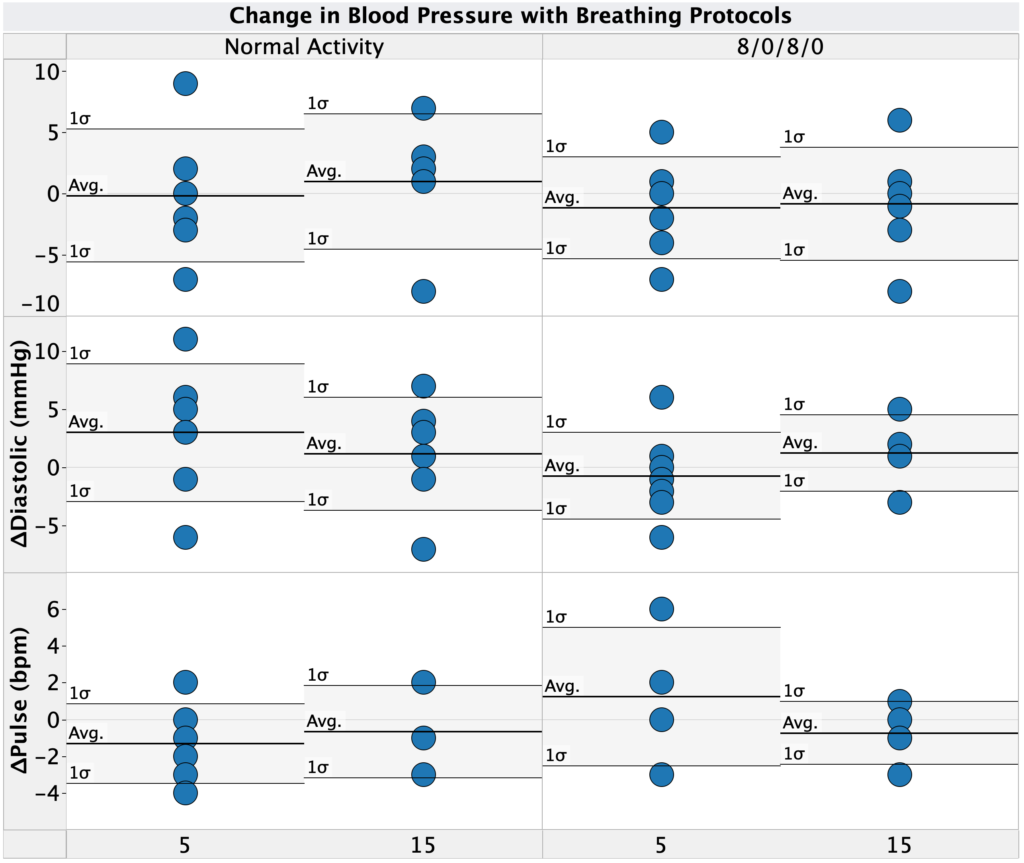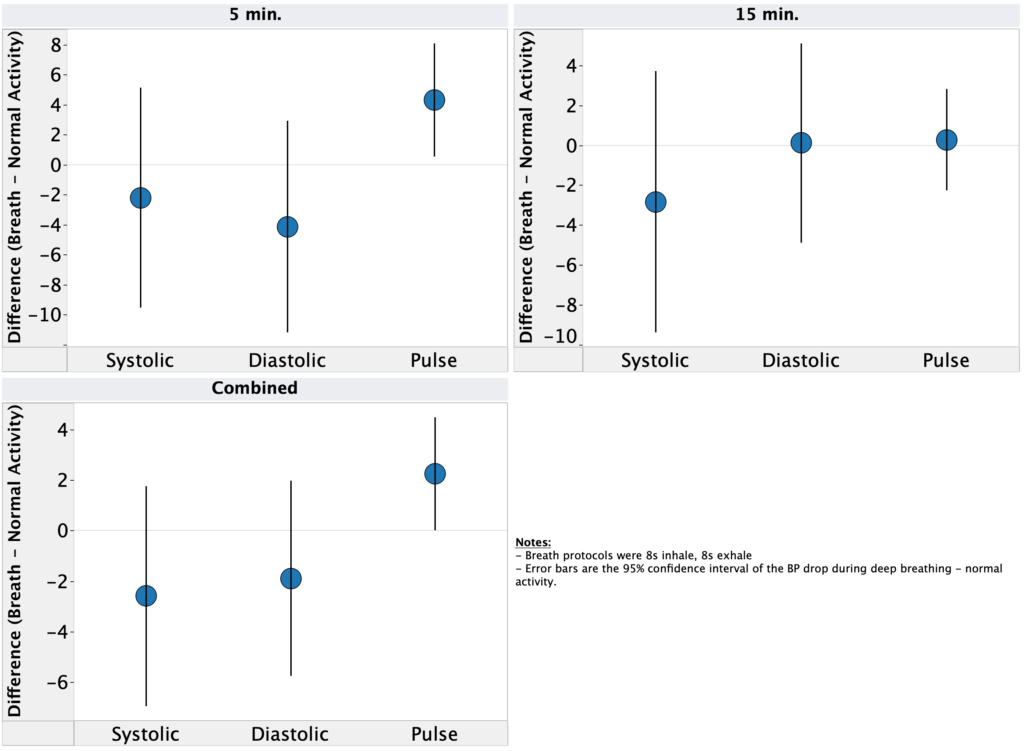Get new posts by email or rss feed
For my studies to determine ways to reduce my blood pressure, the first intervention I’m testing is deep breathing protocols. Here I report my initial results:
Summary
- Background:
- Numerous studies, reviews, and meta-analyses have shown deep breathing to lower blood pressure in both the short and long-term (example 1, example 2).
- Effect sizes are moderate (3-5 mmHg) and statistically significant for large patient populations (>10,000 patients in some studies).
- Numerous breathing protocols have been tested, with varying results.
- My own quick tests suggested a possible effect.
- Approach:
- Blood pressure and pulse were measured each morning before and after the following protocols:
- 8s inhale, 8s exhale, 5 min.
- Normal activity, 5 min.
- 8s inhale, 8s exhale, 15 min.
- Normal activity, 15 min.
- Each protocol/time combination was measured 5 times.
- Average and 95% confidence intervals were compared for each metric & protocol.
- Blood pressure and pulse were measured each morning before and after the following protocols:
- Results & Conclusions:
- For each time condition, a blood pressure drop was observed on average during deep breathing, while an increase was observed during normal activity. The opposite effect was observed for pulse (increased during deep breathing).
- Due to the high variance in the measurements, the 95% confidence interval for the difference overlaps zero, so the results are not statistically significant and could easily be due to chance.
- Next Steps:
- I will repeat the experiments, but measure blood pressure 5 times for each observation, increasing measurement precision.
- For these experiments, I will test only 5 min. deep breathing and normal activity, but run 10 trials of each, with an interim analysis at 5 trials each.



Details
Purpose
- To determine the effect of deep breathing protocols on short-term blood pressure.
Background
For additional background, see previous post.
- Numerous studies, reviews, and meta-analyses have shown deep breathing to lower blood pressure in both the short and long-term (example 1, example 2).
- Effect sizes are moderate (3-5 mmHg) and statistically significant for large patient populations (>10,000 patients in some studies).
- Numerous breathing protocols have been tested, with varying results.
- My own quick tests suggested a possible effect.
Results & Discussion
Caveat
All of these experiments were done before I tested the repeatability of my blood pressure meter and I only took one measurement per observation (i.e. one measurement before and one after each period). This was a big mistake on my part, as the variance between measurements was way to high and no results are statistically significant (i.e. could easily be due to chance).
Given this, please take all discussion/conclusions presented here as only suggestive for further experiments. I will be repeating this work with 5 measurements per observation.
Blood Pressure & Pulse Change during the Interventions
First, let’s take a look at the change in blood pressure during each session. As shown in both the table and graphs above, on average:
- Systolic pressure dropped in both the 5 & 15 min. deep breathing conditions, while it increased during normal activity.
- Diastolic pressure dropped in the 5 min. deep breathing condition, increased during 15 min., and increased in both times for normal activity
- Pulse increased during 5 min. deep breathing, dropped during 15 min., and dropped in both times for normal activity
As discussed above, the 95% confidence interval overlaps zero for all of these measurements, so the results could easily be due to chance. However, they are consistent with my initial exploratory measurements.
Looking at the difference between means for each time condition, I see a drop of ~2.5 mmHg for systolic pressure, ~2 mmHg for diastolic, and an increase of ~2 bpm for pulse for deep breathing vs. normal activity. Again, 95% CI overlaps zero for all conditions, but the effect size is on the edge of worthwhile (I had pre-registered that I would follow up on effect sizes >3 mmHg).
Conclusions & Next Experiments
Given the high observed variance, I am going to repeat these experiments with my new measurement protocol (5 measurements/observation). I have already started these experiments and should have them completed in ~2 weeks. In the meantime, I will finish up analyzing my historical data and report that out next week.
– QD
Methods
Pre-registration
Here.
Differences from original pre-registration:
- Instead of using students t-test, I compared 95% confidence intervals between conditions (mathematically equivalent for a threshold of p = 0.05)
Blinding
This experiment was not blinded
Procedure
- Each morning at ~6am, I measured my blood pressure before and after the following protocols:
- 8s inhale, 8s exhale, 5 min.
- Normal activity, 5 min.
- 8s inhale, 8s exhale, 15 min.
- Normal activity, 15 min.
- Breath timing was controlled using the iBreath app.
- Blood pressure measurements were performed using an Omron Evolve blood pressure meter.
- For each measurement, I placed the meter on my left arm, ~4 cm above my elbow. Measurements were taken seated, with my feet on the ground and arms resting on a flat surface at a comfortable height (same every time).
Data Visualization
Data was visualized using Tableau.